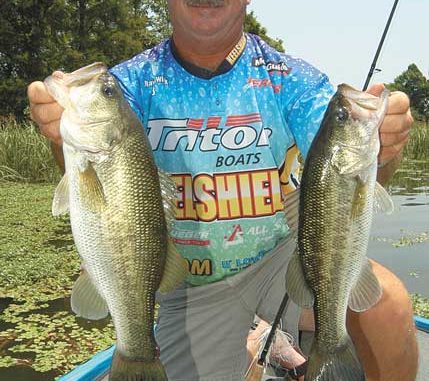
Santee Cooper fishes like the good ol’ days during April’s bass bonanza.
There’s no denying that the bass fishing on the Santee Cooper reservoirs is nothing compared to the “good ol’ days.”
The hydrilla is gone, the water has cleared up, and bass can sometimes be hard to come by.
Thank heavens for springtime.
“It’s pretty easy to catch ’em from mid-March through April and to mid-May,” said Ray Sedgwick of Cross, who retired from professional bass fishing last fall after a career that spanned 15 years and featured three appearances in the Bassmasters Classic, the Super Bowl of bass fishing.
“The bass fishing has steadily gotten worse and worse,” said veteran Santee Cooper angler Henry McFadden of Georgetown. “But March and April, that’s still when everybody can catch ’em.”
What happened? The guesses from fishermen are numerous and varied, but most of them center on the removal of the hydrilla that blanked large portions of Lake Moultrie and Lake Marion through the 1980s and 1990s. Then, there’s the clear-water issue — the stained water that spawned great fishing is largely gone, replaced with water that often approaches gin-clear status.
Whatever the reason, it’s different, and fishermen who haven’t kept up with the changes have fallen by the wayside.
“It used to be that we could catch staging or prespawn fish,” said Sedgwick, who owns Canal Lakes Fish Camp on the Diversion Canal that connects 110,600-acre Lake Marion — the “upper lake” — with 61,000-acre Lake Moultrie — the “lower lake.”
“Brushpiles used to be part of our arsenal. You can still catch a few fish around them in 10 to 15 feet of water, but they aren’t as productive as they’ve been in the past.
“Now, bass are hard to catch staging,” he said. “In years past, I put out brushpiles to catch ’em coming in. Now, they just come in from wherever they are to the bed, then, they’re gone.”
But when they invade the shallows, watch out.
“When you get a bite, it will be a good one — at least a 4- or 5-pound fish,” said McFadden, who had the best tutor around as a youngster; his father, Sonny McFadden, one of Santee’s legendary guides. “It’s good those two months, but when its over in May, it gets tough.”
So, if it’s tough nine months out of the year, why is it so easy for such a short period of time? Partly, it’s because the two lakes are rich in shallow cover; lily pads, gator grass, primrose, stump flats and trees — cypress and tupelo. Bass will spawn around those kinds of cover almost exclusively, and catching them is just a matter of being able to key in on productive areas.
McFadden, who is one of the most successful redfish pros in South Carolina, said bass bite early in the day around the vegetation and later in the day around the wood.
“The gator grass is the early bite,” he said. “Up in the day, when the sun gets up, then you go looking around trees. I’ll start in the gator grass and the lily pads early; they’ll hit a floating worm. Then, when the sun gets up, they’ll go to certain trees. There may be 60 trees in an area, and they’ll be on three of them. You just have to know which three.
“My dad has guided all of his life, and I learned bass fishing from him. He showed me the trees that held fish, and I’ve learned that they’ll still produce, year-in and year-out. They still hold fish.”
Is there a trick to picking out the key trees? Sedgwick thinks so; at least there seems to be some rhyme and reason why a handful of trees in an area of 20 surface acres will hold bass while the rest are empty.
Go to our archives to read the rest of this story, which first appeared in the April 2009 issue of South Carolina Sportsman magazine. Subscribe to ensure every information-packed issue is delivered right to your door.
Read up-to-date fishing reports and post your own reports by going to our fishing forum. If you aren’t already a registered member of this site, click here to get started today!





Be the first to comment